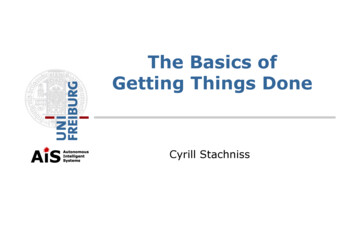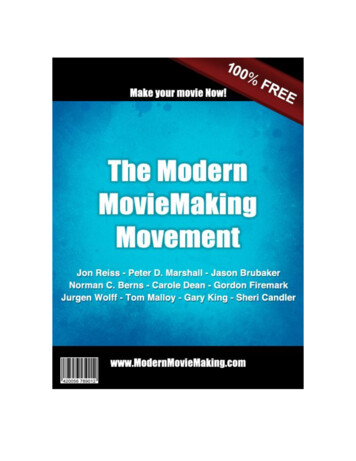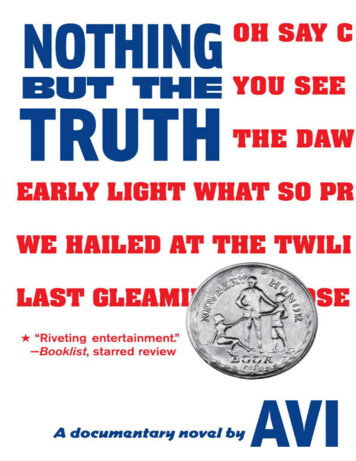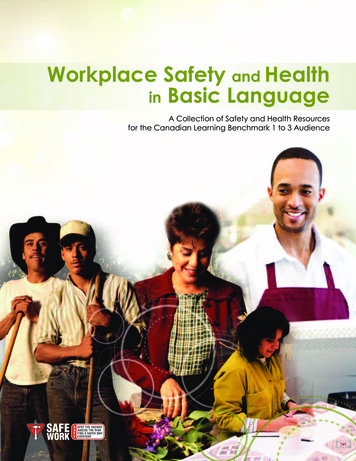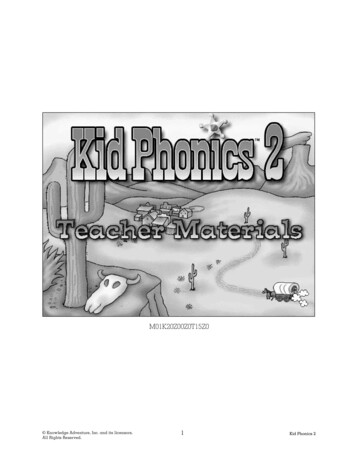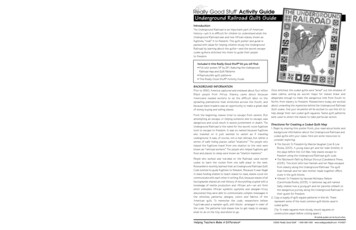
Transcription
Really Good Stuff Activity Guide Underground Railroad Quilt GuideIntroductionThe Underground Railroad is an important part of Americanhistory—yet it is difficult for children to understand what theUnderground Railroad was and how African slaves, known asfugitives, “rode” it to freedom. This quilt poster and guide ispacked with ideas for helping children study the UndergroundRailroad by learning about the quilts—and the secret escapecodes quilters stitched into them to guide their peopleto freedom.Included in this Really Good Stuff kit you will find: Full-color poster, 19" by 24", featuring the UndergroundRailroad map and Quilt Patterns Reproducible quilt patterns This Really Good Stuff Activity GuideBACKGROUND INFORMATIONPrior to 1860, America captured and enslaved about four millionBlack people from Africa. Slavery came about becauseAmericans needed workers to do the difficult labor on thesprawling plantations that stretched across the South, andbecause slave-traders saw an opportunity to make a great dealof money buying and selling slaves.From the beginning, slaves tried to escape from owners. Butattempting an escape, or helping someone else to escape, wasdangerous and could result in severe punishment or death. TheUnderground Railroad is the name for the secret route fugitivestook to escape to freedom. It was so named because fugitiveswho traveled on it just seemed to vanish as if travelingunderground. It was, of course, not a real railroad, but rather aseries of safe hiding places called “stations.” The people whohelped the fugitives travel from one station to the next wereknown as “railroad workers.” The people who helped fugitives getfood and places to sleep were known as “station masters.”People who worked and tra veled on the Railroad used secretcodes to learn the routes from one safe place to the next.R e s e a rchers recently learned that an Underground Railroad QuiltCode existed to guide fugitives to freedom. Because it was illegalin slave-holding states to teach slaves to read, slaves could notcommunicate with each other in writing. But, because slaves of allb a c k g rounds shared an oral history of storytelling coupled with aknowledge of textile production and African art—an art formwhich embodies African symbolic systems and designs—t h e ydiscovered they we re able to communicate complex messages inthe stitches, patterns, designs, colors and fabrics of theAmerican quilt. To memorize the code, researchers believef u g i t i ves used a sampler quilt, with blocks arranged in order ofthe code. The patterns told slaves how to get ready to escape,what to do on the trip, and where to go.Once stitched, the coded quilts were “aired” out the windows ofslave cabins, acting as secret maps for slaves brave anddesperate enough to make the dangerous trek from South toNorth, from slavery to freedom. Researchers today are excitedabout unraveling the mysteries behind the Underground RailroadQuilt codes. And your students will be excited to use this kit tohelp design their own coded quilt squares. Twelve quilt patternswere used to direct the slaves to take particular action.Directions for Creating a Coded Quilt Map1. Begin by sharing this poster front, plus read-aloud books andbackground information about the Underground Railroad andcoded quilts with your class. Here are some resources toconsider exploring: The Secret To Freedom by Marcia Vaughan (Lee & LowBooks, 2001). A young slave girl and her older brother, inthe days before the Civil War, help slaves escape tofreedom using the Underground Railroad quilt code. The Patchwork Path by Bettye Stroud (Candlewick Press,2005). This book tells how Hannah and her Papa escapedfrom slavery along the Underground Railroad. The quiltthat Hannah and her late mother made together offersclues in the quilt blocks. Almost To Freedom by Vaunda Micheaux Nelson(Carolrhoda Books, 2003). A tattered rag doll namedSally relates how a young girl and her parents embark onthe dangerous journey along the Underground Railroad intheir quest for freedom.2. Copy a supply of quilt square patterns in this kit. Theserepresent some of the most common quilt blocks used incoded quilts.(Tip: To make squares more sturdy, mount squares onconstruction paper before cutting apart . )All activity guides can be found online:Helping Teachers Make A Difference 2005 Really Good Stuff 1-800-366-1920 www.reallygoodstuff.com #154227Helping Teachers Make A Difference 2005 Really Good Stuff 1-800-366-1920 www.reallygoodstuff.com #154227
Really Good Stuff Activity Guide Underground Railroad Quilt Guide3. After reading together the information about eachquilt block: Offer children art supplies (crayons, markers, assortedpaper, wrapping paper, fabric scraps and scissors). Have them trim the squares along the lines, then fill in thesquares with color, patterns and textures. Tell children to create quilt squares with hidden meanings.Remind them that colors, patterns, textures, “stitches”and “knots” (drawn on with a fine line marker), can eachindicate a coded symbol. Children can create individual squares which may be tapedor quilted together as a class quilt, or they may createindividual quilts by gluing a number of completed squaresto lengths of craft paper which can then be displayed onwalls and hallways.4. Invite children to write essays describing the symbolismpresent in their quilt square(s).QUILT PATTERNS & THEIR MEANINGSMonkey WrenchThis meant the slaves were to gather all thetools they might need on the journey tofreedom. Tools meant: something with whichto build shelters, compasses fordetermining direction, or tools to serve asweapons for defending themselves.Wagon WheelThis was the second pattern to bedisplayed, which signaled the slaves to packall the things that would go in a wagon orthat would be used during their journey. Thiswas a signal for the slaves to think aboutwhat essentials they needed to survivethe trip.Carpenter’s Wheel(Wagon Wheel variation)This pattern would have particularsignificance to slaves skilled in a craft—such as carpentry. (Other such patternsmight be: an Anvil, Circular Saw, Square andCompass.) It was also a symbol to “stealaway”—a visual equivalent to the popularspiritual “Steal Away”, which many slavesknew and sang. The pattern told slavesto “run with faith” to the west—northwest territories.Bear’s PawIt’s believed that this pattern wassometimes used to help fugitives follow thepath of the bear, and to identify landmarkson the edge of the plantation.Helping Teachers Make A Difference CrossroadsOnce through the mountains, slaves were totravel to the crossroads. The main crossroadwas Cleveland, Ohio. Any quilt hung beforethis one would have given directions to Ohio.Log CabinThis pattern was used to let the slaves knowwhere safe houses were. People who helpedthe Underground Railroad may have identifiedthemselves as friends to slaves on the run bytracing this pattern in dirt as a signal. Thisquilt told slaves to look for this symbol ontheir journey to freedom. It was also asymbol to set up a “home” in a free state.ShooflyLittle is known about this pattern. It isbelieved that Shoofly refers to an actualperson who might have aided escaping slaves.Bow TiesSlaves’ clothes were often tattered and easyto spot. This pattern meant that someonewould bring the slave nice clothes to helpthem blend in with the free blacks.Flying GeeseThis pattern told the slaves to followmigrating geese north towards Canada andto freedom. This pattern was used asdirections as well as the best season forslaves to escape. Geese fly north in thespring and summer. Flying geese pointed tothe direction, north, for the slaves to move.Also, geese would have to stop at waterwaysalong their journey in order to rest and eat.Slaves were to take their cues on direction,timing and behavior from the migrating geese.Drunkard’s PathThis was a clear warning for the slaves tomove in a staggering fashion so as to eludeany following slave hunters. It was suggestedthat slaves even double back to eludetheir pursuers.North Star (Evening Star/Star)This instructed the slaves to follow theNorth Star to Canada and to freedom.Tumbling Blocks (Boxes)This signaled to the slaves—by the numberof boxes and knots—the time to “box up” allone’s belongings in preparation to escape. 2005 Really Good Stuff 1-800-366-1920 www.reallygoodstuff.com #154227Helping Teachers Make A Difference 2005 Really Good Stuff 1-800-366-1920 www.reallygoodstuff.com #154227
Really Good Stuff Activity Guide Underground Railroad Quilt Guide3. After reading together the information about eachquilt block: Offer children art supplies (crayons, markers, assortedpaper, wrapping paper, fabric scraps and scissors). Have them trim the squares along the lines, then fill in thesquares with color, patterns and textures. Tell children to create quilt squares with hidden meanings.Remind them that colors, patterns, textures, “stitches”and “knots” (drawn on with a fine line marker), can eachindicate a coded symbol. Children can create individual squares which may be tapedor quilted together as a class quilt, or they may createindividual quilts by gluing a number of completed squaresto lengths of craft paper which can then be displayed onwalls and hallways.4. Invite children to write essays describing the symbolismpresent in their quilt square(s).QUILT PATTERNS & THEIR MEANINGSMonkey WrenchThis meant the slaves were to gather all thetools they might need on the journey tofreedom. Tools meant: something with whichto build shelters, compasses fordetermining direction, or tools to serve asweapons for defending themselves.Wagon WheelThis was the second pattern to bedisplayed, which signaled the slaves to packall the things that would go in a wagon orthat would be used during their journey. Thiswas a signal for the slaves to think aboutwhat essentials they needed to survivethe trip.Carpenter’s Wheel(Wagon Wheel variation)This pattern would have particularsignificance to slaves skilled in a craft—such as carpentry. (Other such patternsmight be: an Anvil, Circular Saw, Square andCompass.) It was also a symbol to “stealaway”—a visual equivalent to the popularspiritual “Steal Away”, which many slavesknew and sang. The pattern told slavesto “run with faith” to the west—northwest territories.Bear’s PawIt’s believed that this pattern wassometimes used to help fugitives follow thepath of the bear, and to identify landmarkson the edge of the plantation.Helping Teachers Make A Difference CrossroadsOnce through the mountains, slaves were totravel to the crossroads. The main crossroadwas Cleveland, Ohio. Any quilt hung beforethis one would have given directions to Ohio.Log CabinThis pattern was used to let the slaves knowwhere safe houses were. People who helpedthe Underground Railroad may have identifiedthemselves as friends to slaves on the run bytracing this pattern in dirt as a signal. Thisquilt told slaves to look for this symbol ontheir journey to freedom. It was also asymbol to set up a “home” in a free state.ShooflyLittle is known about this pattern. It isbelieved that Shoofly refers to an actualperson who might have aided escaping slaves.Bow TiesSlaves’ clothes were often tattered and easyto spot. This pattern meant that someonewould bring the slave nice clothes to helpthem blend in with the free blacks.Flying GeeseThis pattern told the slaves to followmigrating geese north towards Canada andto freedom. This pattern was used asdirections as well as the best season forslaves to escape. Geese fly north in thespring and summer. Flying geese pointed tothe direction, north, for the slaves to move.Also, geese would have to stop at waterwaysalong their journey in order to rest and eat.Slaves were to take their cues on direction,timing and behavior from the migrating geese.Drunkard’s PathThis was a clear warning for the slaves tomove in a staggering fashion so as to eludeany following slave hunters. It was suggestedthat slaves even double back to eludetheir pursuers.North Star (Evening Star/Star)This instructed the slaves to follow theNorth Star to Canada and to freedom.Tumbling Blocks (Boxes)This signaled to the slaves—by the numberof boxes and knots—the time to “box up” allone’s belongings in preparation to escape. 2005 Really Good Stuff 1-800-366-1920 www.reallygoodstuff.com #154227Helping Teachers Make A Difference 2005 Really Good Stuff 1-800-366-1920 www.reallygoodstuff.com #154227
Helping Teachers Make A Difference 2005 Really Good Stuff 1-800-366-1920 www.reallygoodstuff.com #154227Helping Teachers Make A Difference 2005 Really Good Stuff 1-800-366-1920 www.reallygoodstuff.com #154227
Helping Teachers Make A Difference 2005 Really Good Stuff 1-800-366-1920 www.reallygoodstuff.com #154227Helping Teachers Make A Difference 2005 Really Good Stuff 1-800-366-1920 www.reallygoodstuff.com #154227
Helping Teachers Make A Difference 2005 Really Good Stuff 1-800-366-1920 www.reallygoodstuff.com #154227Helping Teachers Make A Difference 2005 Really Good Stuff 1-800-366-1920 www.reallygoodstuff.com #154227
Helping Teachers Make A Difference 2005 Really Good Stuff 1-800-366-1920 www.reallygoodstuff.com #154227Helping Teachers Make A Difference 2005 Really Good Stuff 1-800-366-1920 www.reallygoodstuff.com #154227
Really Good Stuff Activity Guide Underground Railroad Quilt GuideIntroductionThe Underground Railroad is an important part of Americanhistory—yet it is difficult for children to understand what theUnderground Railroad was and how African slaves, known asfugitives, “rode” it to freedom. This quilt poster and guide ispacked with ideas for helping children study the UndergroundRailroad by learning about the quilts—and the secret escapecodes quilters stitched into them to guide their peopleto freedom.Included in this Really Good Stuff kit you will find: Full-color poster, 19" by 24", featuring the UndergroundRailroad map and Quilt Patterns Reproducible quilt patterns This Really Good Stuff Activity GuideBACKGROUND INFORMATIONPrior to 1860, America captured and enslaved about four millionBlack people from Africa. Slavery came about becauseAmericans needed workers to do the difficult labor on thesprawling plantations that stretched across the South, andbecause slave-traders saw an opportunity to make a great dealof money buying and selling slaves.From the beginning, slaves tried to escape from owners. Butattempting an escape, or helping someone else to escape, wasdangerous and could result in severe punishment or death. TheUnderground Railroad is the name for the secret route fugitivestook to escape to freedom. It was so named because fugitiveswho traveled on it just seemed to vanish as if travelingunderground. It was, of course, not a real railroad, but rather aseries of safe hiding places called “stations.” The people whohelped the fugitives travel from one station to the next wereknown as “railroad workers.” The people who helped fugitives getfood and places to sleep were known as “station masters.”People who worked and tra veled on the Railroad used secretcodes to learn the routes from one safe place to the next.R e s e a rchers recently learned that an Underground Railroad QuiltCode existed to guide fugitives to freedom. Because it was illegalin slave-holding states to teach slaves to read, slaves could notcommunicate with each other in writing. But, because slaves of allb a c k g rounds shared an oral history of storytelling coupled with aknowledge of textile production and African art—an art formwhich embodies African symbolic systems and designs—t h e ydiscovered they we re able to communicate complex messages inthe stitches, patterns, designs, colors and fabrics of theAmerican quilt. To memorize the code, researchers believef u g i t i ves used a sampler quilt, with blocks arranged in order ofthe code. The patterns told slaves how to get ready to escape,what to do on the trip, and where to go.Once stitched, the coded quilts were “aired” out the windows ofslave cabins, acting as secret maps for slaves brave anddesperate enough to make the dangerous trek from South toNorth, from slavery to freedom. Researchers today are excitedabout unraveling the mysteries behind the Underground RailroadQuilt codes. And your students will be excited to use this kit tohelp design their own coded quilt squares. Twelve quilt patternswere used to direct the slaves to take particular action.Directions for Creating a Coded Quilt Map1. Begin by sharing this poster front, plus read-aloud books andbackground information about the Underground Railroad andcoded quilts with your class. Here are some resources toconsider exploring: The Secret To Freedom by Marcia Vaughan (Lee & LowBooks, 2001). A young slave girl and her older brother, inthe days before the Civil War, help slaves escape tofreedom using the Underground Railroad quilt code. The Patchwork Path by Bettye Stroud (Candlewick Press,2005). This book tells how Hannah and her Papa escapedfrom slavery along the Underground Railroad. The quiltthat Hannah and her late mother made together offersclues in the quilt blocks. Almost To Freedom by Vaunda Micheaux Nelson(Carolrhoda Books, 2003). A tattered rag doll namedSally relates how a young girl and her parents embark onthe dangerous journey along the Underground Railroad intheir quest for freedom.2. Copy a supply of quilt square patterns in this kit. Theserepresent some of the most common quilt blocks used incoded quilts.(Tip: To make squares more sturdy, mount squares onconstruction paper before cutting apart . )All activity guides can be found online:Helping Teachers Make A Difference 2005 Really Good Stuff 1-800-366-1920 www.reallygoodstuff.com #154227Helping Teachers Make A Difference 2005 Really Good Stuff 1-800-366-1920 www.reallygoodstuff.com #154227
2005). This book tells how Hannah and her Papa escaped from slavery along the Underground Railroad. The quilt that Hannah and her late mother made together offers clues in the quilt blocks. Almost To Freedomby Vaunda Micheaux Nelson (Carolrhoda Books, 2003). A tattered rag doll named Sally relates how a young girl and her parents embark on
